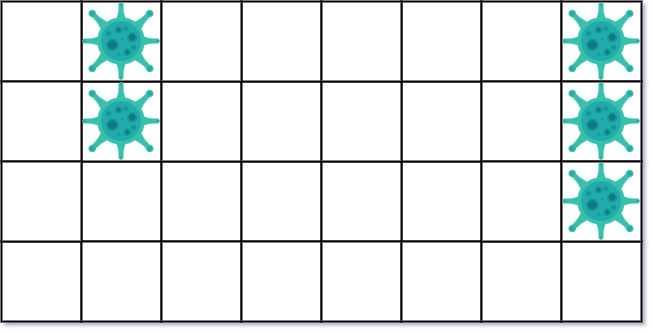LC 749. 隔离病毒
题目描述
这是 LeetCode 上的 749. 隔离病毒 ,难度为 困难。
病毒扩散得很快,现在你的任务是尽可能地通过安装防火墙来隔离病毒。
假设世界由 $m \times n$ 的二维矩阵 isInfected 组成,isInfected[i][j] == 0 表示该区域未感染病毒,而 isInfected[i][j] == 1 表示该区域已感染病毒。可以在任意 $2$ 个相邻单元之间的共享边界上安装一个防火墙(并且只有一个防火墙)。
每天晚上,病毒会从被感染区域向相邻未感染区域扩散,除非被防火墙隔离。现由于资源有限,每天你只能安装一系列防火墙来隔离其中一个被病毒感染的区域(一个区域或连续的一片区域),且该感染区域对未感染区域的威胁最大且 保证唯一 。
你需要努力使得最后有部分区域不被病毒感染,如果可以成功,那么返回需要使用的防火墙个数; 如果无法实现,则返回在世界被病毒全部感染时已安装的防火墙个数。
示例 1:

1 | |

示例 2:

1 | |
示例 3:1
2
3
4
5输入: isInfected = [[1,1,1,0,0,0,0,0,0],[1,0,1,0,1,1,1,1,1],[1,1,1,0,0,0,0,0,0]]
输出: 13
解释: 在隔离右边感染区域后,隔离左边病毒区域只需要 2 个防火墙。
提示:
- $m = isInfected.length$
- $n = isInfected[i].length$
- $1 <= m, n <= 50$
isInfected[i][j]is either0or1- 在整个描述的过程中,总有一个相邻的病毒区域,它将在下一轮严格地感染更多未受污染的方块
搜索模拟
根据题意,我们可以按天进行模拟,设计函数 getCnt 用于返回当天会被安装的防火墙数量,在 getCnt 内部我们会进行如下操作:
- 找出当天「对未感染区域的威胁最大」的区域,并将该区域进行隔离(将 $1$ 设置为 $-1$);
- 对其他区域,进行步长为 $1$ 的感染操作。
考虑如何实现 getCnt:我们需要以「连通块」为单位进行处理,因此每次的 getCnt 操作,我们先重建一个与矩阵等大的判重数组 vis,对于每个 $g[i][j] = 1$ 且未被 $vis[i][j]$ 标记为 True 的位置进行搜索,搜索过程使用 BFS 实现。
在 BFS 过程中,我们除了统计该连通块所需要的防火墙数量 $b$ 以外,还需要额外记录当前连通块中 $1$ 的点集 s1(简称为原集,含义为连通块的格子集合),以及当前连通块相邻的 $0$ 的点集 s2(简称为扩充集,含义为将要被感染的格子集合)。
根据题意,在单次的 getCnt 中,我们需要在所有连通块中取出其 s2 大小最大(对未感染区域的威胁最大)的连通块进行隔离操作,而其余连通块则进行扩充操作。
因此我们可以使用两个变量 max 和 ans 分别记录所有 s2 中的最大值,以及取得最大 s2 所对应连通块所需要的防火墙数量,同时需要使用两个数组 l1 和 l2 分别记录每个连通块对应的「原集」和「扩充集」,方便我们后续进行「隔离」和「感染」。
Java 代码:1
2
3
4
5
6
7
8
9
10
11
12
13
14
15
16
17
18
19
20
21
22
23
24
25
26
27
28
29
30
31
32
33
34
35
36
37
38
39
40
41
42
43
44
45
46
47
48
49
50
51
52
53
54
55
56
57
58
59
60
61
62
63
64
65
66class Solution {
int[][] g;
int n, m, ans;
int[][] dirs = new int[][]{{1,0},{-1,0},{0,1},{0,-1}};
boolean[][] vis;
int search(int _x, int _y, Set<Integer> s1, Set<Integer> s2) {
int ans = 0;
Deque<int[]> d = new ArrayDeque<>();
vis[_x][_y] = true;
d.addLast(new int[]{_x, _y});
s1.add(_x * m + _y);
while (!d.isEmpty()) {
int[] info = d.pollFirst();
int x = info[0], y = info[1];
for (int[] di : dirs) {
int nx = x + di[0], ny = y + di[1], loc = nx * m + ny;
if (nx < 0 || nx >= n || ny < 0 || ny >= m || vis[nx][ny]) continue;
if (g[nx][ny] == 1) {
s1.add(loc);
vis[nx][ny] = true;
d.addLast(new int[]{nx, ny});
} else if (g[nx][ny] == 0) {
s2.add(loc);
ans++;
}
}
}
return ans;
}
int getCnt() {
vis = new boolean[n][m];
int max = 0, ans = 0;
// l1: 每个连通块的点集 s2: 每个连通块的候选感染点集
List<Set<Integer>> l1 = new ArrayList<>(), l2 = new ArrayList<>();
for (int i = 0; i < n; i++) {
for (int j = 0; j < m; j++) {
if (g[i][j] == 1 && !vis[i][j]) {
// s1: 当前连通块的点集 s2: 当前连通块的候选感染点集
Set<Integer> s1 = new HashSet<>(), s2 = new HashSet<>();
int b = search(i, j, s1, s2), a = s2.size();
if (a > max) {
max = a; ans = b;
}
l1.add(s1); l2.add(s2);
}
}
}
for (int i = 0; i < l2.size(); i++) {
for (int loc : l2.get(i).size() == max ? l1.get(i) : l2.get(i)) {
int x = loc / m, y = loc % m;
g[x][y] = l2.get(i).size() == max ? -1 : 1;
}
}
return ans;
}
public int containVirus(int[][] _g) {
g = _g;
n = g.length; m = g[0].length;
while (true) {
int cnt = getCnt();
if (cnt == 0) break;
ans += cnt;
}
return ans;
}
}
C++ 代码:1
2
3
4
5
6
7
8
9
10
11
12
13
14
15
16
17
18
19
20
21
22
23
24
25
26
27
28
29
30
31
32
33
34
35
36
37
38
39
40
41
42
43
44
45
46
47
48
49
50
51
52
53
54
55
56
57
58
59
60
61
62
63
64
65
66
class Solution {
public:
vector<vector<int>> g;
int n, m, ans;
vector<vector<int>> dirs = {{1, 0}, {-1, 0}, {0, 1}, {0, -1}};
vector<vector<bool>> vis;
int search(int _x, int _y, unordered_set<int>& s1, unordered_set<int>& s2) {
int ans = 0;
deque<pair<int, int>> d;
vis[_x][_y] = true;
d.push_back({_x, _y});
s1.insert(_x * m + _y);
while (!d.empty()) {
auto [x, y] = d.front(); d.pop_front();
for (auto& di : dirs) {
int nx = x + di[0], ny = y + di[1], loc = nx * m + ny;
if (nx < 0 || nx >= n || ny < 0 || ny >= m || vis[nx][ny]) continue;
if (g[nx][ny] == 1) {
s1.insert(loc);
vis[nx][ny] = true;
d.push_back({nx, ny});
} else if (g[nx][ny] == 0) {
s2.insert(loc);
ans++;
}
}
}
return ans;
}
int getCnt() {
vis = vector<vector<bool>>(n, vector<bool>(m, false));
int maxv = 0, ans = 0;
vector<unordered_set<int>> l1, l2;
for (int i = 0; i < n; i++) {
for (int j = 0; j < m; j++) {
if (g[i][j] == 1 && !vis[i][j]) {
unordered_set<int> s1, s2;
int b = search(i, j, s1, s2), a = s2.size();
if (a > maxv) {
maxv = a; ans = b;
}
l1.push_back(s1); l2.push_back(s2);
}
}
}
for (int i = 0; i < l2.size(); i++) {
for (int loc : (l2[i].size() == maxv ? l1[i] : l2[i])) {
int x = loc / m, y = loc % m;
g[x][y] = l2[i].size() == maxv ? -1 : 1;
}
}
return ans;
}
int containVirus(vector<vector<int>>& _g) {
g = _g;
n = g.size(); m = g[0].size();
ans = 0;
while (true) {
int cnt = getCnt();
if (cnt == 0) break;
ans += cnt;
}
return ans;
}
};
Python 代码:1
2
3
4
5
6
7
8
9
10
11
12
13
14
15
16
17
18
19
20
21
22
23
24
25
26
27
28
29
30
31
32
33
34
35
36
37
38
39
40
41
42
43
44
45
46
47
48
49
50
51
52
53
54
55class Solution:
def search(self, x, y, s1, s2):
ans = 0
d = deque()
self.vis[x][y] = True
d.append((x, y))
s1.add(x * self.m + y)
while d:
nx, ny = d.popleft()
for dx, dy in self.dirs:
nx_, ny_ = nx + dx, ny + dy
loc = nx_ * self.m + ny_
if nx_ < 0 or nx_ >= self.n or ny_ < 0 or ny_ >= self.m or self.vis[nx_][ny_]:
continue
if self.g[nx_][ny_] == 1:
s1.add(loc)
self.vis[nx_][ny_] = True
d.append((nx_, ny_))
elif self.g[nx_][ny_] == 0:
s2.add(loc)
ans += 1
return ans
def getCnt(self):
self.vis = [[False] * self.m for _ in range(self.n)]
max_area = 0
ans = 0
l1, l2 = [], []
for i in range(self.n):
for j in range(self.m):
if self.g[i][j] == 1 and not self.vis[i][j]:
s1, s2 = set(), set()
b = self.search(i, j, s1, s2), len(s2)
if b[1] > max_area:
max_area = b[1]
ans = b[0]
l1.append(s1)
l2.append(s2)
for i in range(len(l2)):
for loc in (l1[i] if len(l2[i]) == max_area else l2[i]):
x, y = divmod(loc, self.m)
self.g[x][y] = -1 if len(l2[i]) == max_area else 1
return ans
def containVirus(self, g: List[List[int]]) -> int:
self.g = g
self.n = len(g)
self.m = len(g[0])
self.ans = 0
self.dirs = [[1, 0], [-1, 0], [0, 1], [0, -1]]
while True:
cnt = self.getCnt()
if cnt == 0: break
self.ans += cnt
return self.ans
TypeScript 代码:1
2
3
4
5
6
7
8
9
10
11
12
13
14
15
16
17
18
19
20
21
22
23
24
25
26
27
28
29
30
31
32
33
34
35
36
37
38
39
40
41
42
43
44
45
46
47
48
49
50
51
52
53
54
55
56
57
58
59
60
61
62
63
64let g: number[][] = null
let n: number = 0, m: number = 0
let vis: boolean[][] = null
const dirs: number[][] = [[1,0],[-1,0],[0,1],[0,-1]]
function search(_x: number, _y: number, s1: Set<number>, s2: Set<number>): number {
let he = 0, ta = 0, ans = 0
let d: Array<number> = new Array<number>()
s1.add(_x * m + _y)
vis[_x][_y] = true
d[ta++] = _x * m + _y
while (he < ta) {
const poll = d[he++]
const x = Math.floor(poll / m), y = poll % m
for (const di of dirs) {
const nx = x + di[0], ny = y + di[1], loc = nx * m + ny
if (nx < 0 || nx >= n || ny < 0 || ny >= m || vis[nx][ny]) continue
if (g[nx][ny] == 1) {
s1.add(loc)
vis[nx][ny] = true
d[ta++] = loc
} else if (g[nx][ny] == 0) {
s2.add(loc)
ans++
}
}
}
return ans
}
function getCnt(): number {
vis = new Array<Array<boolean>>(n)
for (let i = 0; i < n; i++) vis[i] = new Array<boolean>(m).fill(false)
let max = 0, ans = 0
let l1: Array<Set<number>> = new Array<Set<number>>(), l2: Array<Set<number>> = new Array<Set<number>>()
for (let i = 0; i < n; i++) {
for (let j = 0; j < m; j++) {
if (g[i][j] == 1 && !vis[i][j]) {
let s1 = new Set<number>(), s2 = new Set<number>()
const b = search(i, j, s1, s2), a = s2.size
if (a > max) {
max = a; ans = b
}
l1.push(s1); l2.push(s2)
}
}
}
for (let i = 0; i < l2.length; i++) {
for (let loc of l2[i].size == max ? l1[i] : l2[i]) {
const x = Math.floor(loc / m), y = loc % m
g[x][y] = l2[i].size == max ? -1 : 1
}
}
return ans
}
function containVirus(_g: number[][]): number {
g = _g
n = g.length; m = g[0].length
let ans: number = 0
while (true) {
const cnt = getCnt()
if (cnt == 0) break
ans += cnt
}
return ans
};
- 时间复杂度:最多有 $n + m$ 天需要模拟,每天模拟复杂度 $O(n \times m)$,整体复杂度为 $O((n + m) \times nm)$
- 空间复杂度:$O(nm)$
最后
这是我们「刷穿 LeetCode」系列文章的第 No.749 篇,系列开始于 2021/01/01,截止于起始日 LeetCode 上共有 1916 道题目,部分是有锁题,我们将先把所有不带锁的题目刷完。
在这个系列文章里面,除了讲解解题思路以外,还会尽可能给出最为简洁的代码。如果涉及通解还会相应的代码模板。
为了方便各位同学能够电脑上进行调试和提交代码,我建立了相关的仓库:https://github.com/SharingSource/LogicStack-LeetCode 。
在仓库地址里,你可以看到系列文章的题解链接、系列文章的相应代码、LeetCode 原题链接和其他优选题解。
本博客所有文章除特别声明外,均采用 CC BY-SA 4.0 协议 ,转载请注明出处!
